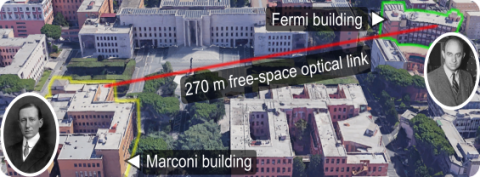The first quantum communication channel developed within the campus of Sapienza University for secure communication

Communicating remotely has become increasingly fundamental in our life: whether it is to talk privately with friends, or to send sensitive data, such as making banking transactions, we need a network that allows us to be connected with the rest of the world.
This calls for consolidating a security system capable of keeping the data exchange safe from unwanted eavesdroppers.
A solution to this problem relies on quantum mechanics, which gives us useful methods in which the communication security is guaranteed by the laws of physics. These methods are known as quantum key distribution: in an encrypted communication, two users employ a secret key to encode any message in a way that is incomprehensible to the outside. This key is transmitted, as the name suggests, exploiting quantum signals.
The safety of such protocols is ensured by the impossibility of duplicating an unknown quantum state, a peculiar property that allows the presence of an eavesdropper to be detected. Even if such a solution has been studied and later experimentally developed with the help of optical technologies, one enormous challenge remains: The optimization of the generation of quantum carriers of information, single photons, as well as of their peculiar correlation property, the quantum entanglement. Indeed, the use of entanglement allows us to provide quantum cryptography with a higher level of security.
In this new work, resulting from a synergetic collaboration between the Nanophotonics group, led by Professor Rinaldo Trotta and the QuantumLab group, led by Professor Fabio Sciarrino, it is shown that is possible to keep safe data transmitted through a communication channel by exploiting a new kind of photon emitter: the quantum dots.
These are semiconductor nanostructures composed of several thousands of atoms (thus with a size of thousands of times smaller than a human hair) that are able, under appropriate conditions, to generate pairs of entangled photons of the highest quality. The young researchers of the two groups used a quantum dot device to distribute a cryptographic key between the two buildings of the Physics Department more than 250 meters apart: This is the first quantum communication channel developed within the campus of Sapienza University.
During the experiment, pairs of entangled photons are separated and sent to the two nodes of the channel, thus allowing the sharing of a secret key while simultaneously checking if an intruder is intercepting the signal sent by measuring the loss of the entanglement.
The novelty of this study, published in the high-profile journal Science Advances and entitled Quantum key distribution with entangled photons generated on-demand by a quantum dot, is related to the introduction of quantum dots in the field of quantum communication; in fact, unlike previous approaches, photon generation in these devices is not based on a probabilistic physical process and it is possible to deliver photons “on demand”, a factor of fundamental importance for the experimental implementation of many remote quantum communication protocols.
With further developments down the line to increase the transmission speed, this technology can aspire for implementation on a global scale.
https://trotta-nanophotonics.weebly.com/
https://www.quantumlab.it
https://www.youtube.com/watch?v=tiIpMdUrceI
https://www.uniroma1.it/it/notizia/conversazioni-crittografate-quando-le...
Authors:
Francesco Basso Basset, Mauro Valeri, Emanuele Roccia, Valerio Muredda, Davide Poderini, Julia Neuwirth, Nicolò Spagnolo, Michele B. Rota, Gonzalo Carvacho, Fabio Sciarrino and Rinaldo Trotta
Reference:
